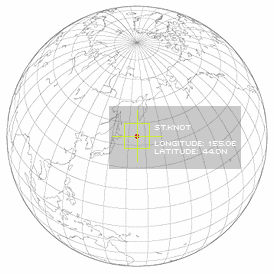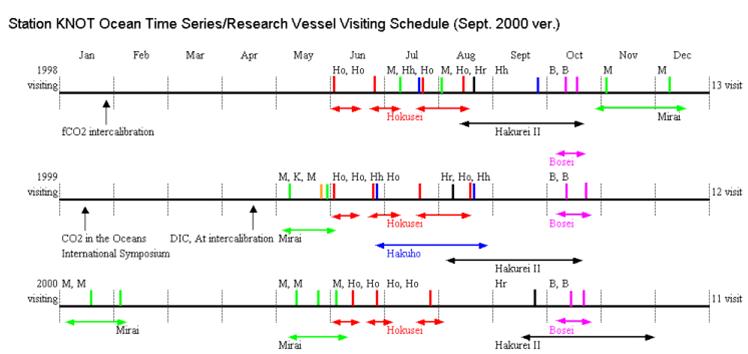--funded by the Japan Science and Technology Corporation (JST)
1. Purpose

In June 1998, Japanese ocean scientists established a time-series observation station in the western North Pacific. The station, located at 44°N, 155°E, is known as KNOT, short for Kyodo North Pacific Ocean Time-series (Kyodo is a Japanese word meaning "collaborative"). The scientific focus of the program at KNOT is the seasonal carbon cycle.
Although the study region exhibits high seasonal variability in sea surface temperature and biological activity, there have been few observations to document the seasonal variations in carbon concentrations and related parameters. The location was chosen because it is located in the western subarctic gyre, and the travel time from Japan to the station is less than three days. In addition, measurements made by Hokkaido University during summer between 1992 and 1997 can be used for comparison.
2. Organization
The KNOT program was proposed by the JGOFS-Japan committee, led by Nobuhiko Handa of Aichi Prefectural University, Shizuo Tsunogai of Hokkaido University and Toshiro Saino of Nagoya University. It is funded by the Japan Science and Technology Corporation (JST) as one of the Core Research for Evaluational Science and Technology (CREST) Programs. The core members of the CREST program include the organizer Yukihiro Nojiri of the National Institute for Environmental Studies, JST post-doctoral fellows Keiri Imai and Nobuo Tsurushima, and JST technicians Fujio Shimano and Takeshi Egashira. Many other Japanese scientists have joined in this program as well.
3. Research Cruises
The biggest challenge of the KNOT program was securing ship time for the fieldwork. There was no single ship dedicated to these time-series observations. Four research vessels have been used for the observations made to date: T/S Hokusei-maru from Hokkaido University, R/V Bosei-maru from Tokai University, R/V Mirai from Japan Marine Science and Technology and R/V Hakuho-maru from the University of Tokyo. Scientific instruments were packed, moved and set again to accommodate each ship change.
The KNOT station was occupied eight times in 1998 and 10 times in 1999 and 2000 respectively. In addition, observations were sometimes made along north-south transects near the KNOT station. In some cases, the KNOT station was occupied twice during on long cruise, with transect work between occupations.

4. Measurement and Analyzing Data
Measurements made during KNOT include carbonate system parameters, including dissolved inorganic carbon (DIC), alkalinity and the fugacity of carbon dioxide (fCO2) in surface waters, as well as temperature, salinity, nutrients and oxygen. Discrete water samples were collected throughout the water column from the surface to at least 3000 meters.
Surface layer measurements of biological activity, including chlorophyll a concentrations and primary productivity, were also made on nearly every cruise, along with collections of phyto- and zooplankton. For more than half the cruises, floating sediment traps were deployed, and measurements were made of particulate and dissolved organic carbon (POC and DOC), iron, trace metals, halocarbons, methane, nitrous oxide, stable isotopic ratios of DIC, the ratio of nitrogen to Oxygen and argon, and thorium-234.
5. Research Results
The latest data set and research results of KNOT are available from KNOT web site.
6. Publications
-- cited from KNOT web site- Fujii, M., Y.Nojiri, Y.Yamanaka, and M.J.Kishi (2002): A one-dimensional ecosystem model applied to time series Station KNOT. Deep Sea Res. II, Vol.49, 5441-5462.
- Imai, K., Y.Nojiri, N.Tsurushima, and T.Saino (2002): Time series of seasonal variation of primary productivity at station KNOT (44°N, 155°E) in the sub-arctic western North Pacific. Deep Sea Res. II, Vol.49, 5395-5408.
- Liu, H., K.Imai, K.Suzuki, Y.Nojiri, N.Tsurushima, and T.Saino (2002): Seasonal variability of picophytoplankton and bacteria in the western subarctic Pacific Ocean at Station KNOT. Deep Sea Res. II, Vol.49, 5409-5420.
- Mochizuki, M., N.Shiga, M.Saito, K.Imai, and Y.Nojiri (2002): Seasonal changes in nutrients, chlorophyll a and the phytoplankton assemblage of the western subarctic gyre in the Pacific Ocean. Deep Sea Res. II, Vol.49, 5421-5440.
- Toyoda, S., N.Yoshida, T.Miwa, Y.Matsui, H.Yamagishi, U.Tsunogai, Y.Nojiri, and N.Tsurushima (2002): Production mechanism and global budget of N2O inferred from its isotopomers in the western North Pacific. Geophysical Research Letters, 29,(3), 10.1029/2001GL014311.
- Tsurushima, N., K.Imai, Y.Nojiri and S. Watanabe (2002): Seasonal variations of carbon dioxide system and nutrients in the surface mixed layer at Station KNOT (44°N, 155°E) in the subarctic wastern North Pacific. Deep Sea Res. II, 5377-5394.
- Tsurushima, N., K.Imai, Y.Nojiri and P.P.Murphy (2002): KNOT: Ocean Time-series Program in western North Pacific completes first phase. US JGOFS News, 11, 4, 11-13. (PDF file)
- Tsurushima, N., Y.Nojiri and S.Watanabe (2000): New Ocean Time Series KNOT in the Western Sub Arctic Pacific from June 1998. Proceedings of 2nd International Symposium of CO2 in the Oceans, ed. by Y. Nojiri.